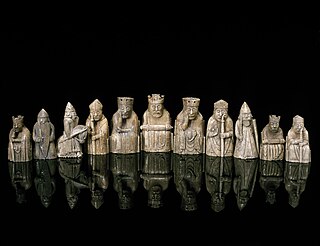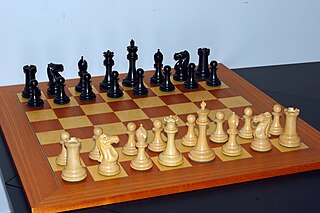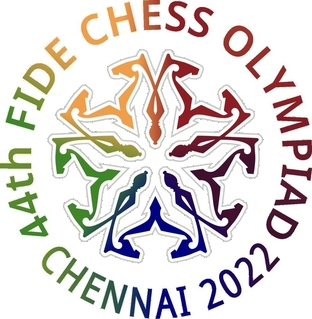
Chess is a board game for two players, called White and Black, each controlling an army of chess pieces, with the objective to checkmate the opponent's king. It is sometimes called international chess or Western chess to distinguish it from related games such as xiangqi and shogi. The recorded history of chess goes back at least to the emergence of a similar game, chaturanga, in seventh century India. The rules of chess as they are known today emerged in Europe at the end of the 15th century, with standardization and universal acceptance by the end of the 19th century. Today, chess is one of the world's most popular games, and is played by millions of people worldwide.

A chessboard is a gameboard used to play chess. It consists of 64 squares, 8 rows by 8 columns, on which the chess pieces are placed. It is square in shape and uses two colours of squares, one light and one dark, in a chequered pattern. During play, the board is oriented such that each player's near-right corner square is a light square.

The rules of chess govern the play of the game of chess. Chess is a two-player abstract strategy board game. Each player controls sixteen pieces of six types on a chessboard. Each type of piece moves in a distinct way. The object of the game is to checkmate the opponent's king; checkmate occurs when a king is threatened with capture and has no escape. A game can end in various ways besides checkmate: a player can resign, and there are several ways a game can end in a draw.
This glossary of chess explains commonly used terms in chess, in alphabetical order. Some of these terms have their own pages, like fork and pin. For a list of unorthodox chess pieces, see Fairy chess piece; for a list of terms specific to chess problems, see Glossary of chess problems; for a list of named opening lines, see List of chess openings; for a list of chess-related games, see List of chess variants; for a list of terms general to board games, see Glossary of board games.

Correspondence chess is chess played by various forms of long-distance correspondence, traditionally through the postal system. Today it is usually played through a correspondence chess server, a public internet chess forum, or email. Less common methods that have been employed include fax, homing pigeon and phone. It is in contrast to over-the-board (OTB) chess, where the players sit at a chessboard at the same time, or play each other in real time via the internet.
In chess, there are a number of ways that a game can end in a draw, neither player winning. Draws are codified by various rules of chess including stalemate, threefold repetition, and the fifty-move rule. Under the standard FIDE rules, a draw also occurs in a dead position, most commonly when neither player has sufficient material to checkmate the opponent.

A chess club is a club formed for the purpose of playing the board game of chess. Chess clubs often provide for both informal and tournament games and sometimes offer league play. Traditionally clubs host over the board, face to face chess more than play on internet chess servers or computer chess.
Chess notation systems are used to record either the moves made or the position of the pieces in a game of chess. Chess notation is used in chess literature, and by players keeping a record of an ongoing game. The earliest systems of notation used lengthy narratives to describe each move; these gradually evolved into more compact notation systems. Algebraic notation is now the accepted international standard, with several variants. Descriptive chess notation was used in English- and Spanish-language literature until the late 20th century, but is now obsolescent. Portable Game Notation (PGN) is a text file format based on English algebraic notation which can be processed by most chess software. Other notation systems include ICCF numeric notation, used for international correspondence chess, and systems for transmission using Morse code over telegraph or radio. The standard system for recording chess positions is Forsyth–Edwards Notation (FEN).

The history of chess can be traced back nearly 1,500 years to its earliest known predecessor, called chaturanga, in India; its prehistory is the subject of speculation. From India it spread to Persia, where it was modified in terms of shapes and rules and developed into Shatranj. Following the Arab invasion and conquest of Persia, chess was taken up by the Muslim world and subsequently spread to Europe via Spain and Italy. The game evolved roughly into its current form by about 1500 CE.

A chess set consists of a chessboard and white and black chess pieces for playing chess. There are sixteen pieces of each color: one king, one queen, two rooks, two bishops, two knights, and eight pawns. Extra pieces may be provided for use in promotion, most commonly one extra queen per color. Chess boxes, chess clocks, and chess tables are common pieces of chess equipment used alongside chess sets. Chess sets are made in a wide variety of styles, sometimes for ornamental rather than practical purposes. For tournament play, the Staunton chess set is preferred and, in some cases, required.

The Staunton chess set is the standard style of chess pieces, recommended for use in competition by FIDE, the international chess governing body.

In chess, the player who moves first is called White and the player who moves second is called Black. Their pieces are the white pieces and the black pieces. The pieces are often not literally white and black, but some other colors, usually a light color and a dark color. The 64 squares of the chessboard, which is colored in a checkered pattern, are likewise the "white squares" or "light squares", and "black squares" or "dark squares"; they are usually of contrasting light and dark color rather than literally white and black. For example, the squares on vinyl boards may be off-white ("buff") and green, while those on wood boards are often light brown and dark brown.
white: 1. There are 16 light-colored pieces and 32 squares called white. 2. When capitalized, the word refers to the player of the white pieces.

A chess title is a title regulated by a chess governing body and bestowed upon players based on their performance and rank. Such titles are usually granted for life. The international chess governing body FIDE grants several titles, the most prestigious of which is Grandmaster; many national chess federations also grant titles such as "National Master". More broadly, the term "master" can refer to any highly skilled chess player.

A chess tournament is a series of chess games played competitively to determine a winning individual or team. Since the first international chess tournament in London, 1851, chess tournaments have become the standard form of chess competition among serious players.
A chess rating system is a system used in chess to estimate the strength of a player, based on their performance versus other players. They are used by organizations such as FIDE, the US Chess Federation, International Correspondence Chess Federation, and the English Chess Federation. Most of the systems are used to recalculate ratings after a tournament or match but some are used to recalculate ratings after individual games. Popular online chess sites such as chess.com, Lichess, and Internet Chess Club also implement rating systems. In almost all systems, a higher number indicates a stronger player. In general, players' ratings go up if they perform better than expected and down if they perform worse than expected. The magnitude of the change depends on the rating of their opponents. The Elo rating system is currently the most widely used.

The International Braille Chess Association (IBCA) is an organization for blind and visually impaired chess players. The IBCA is a FIDE-affiliated chess organization as well as a part of the International Blind Sports Federation. The International Braille Chess Association originated informally in 1951 with the organization of the first international correspondence chess tournament for blind players; the tournament included 20 players representing 10 countries. It first organized an over-the-board tournament in 1958, with representatives from seven countries. Today, it has grown to encompass over 50 member nations around the world. The IBCA hosts two major competitions: the Blind Chess Olympiad and the Blind World Chess Championship.

The following outline is provided as an overview of and topical guide to chess:

The 42nd Chess Olympiad, organised by the Fédération Internationale des Échecs (FIDE) and comprising an open and women's tournaments, as well as several events designed to promote the game of chess, was an international team chess event held in Baku, Azerbaijan, from 1 to 14 September 2016. It was the first time that the Chess Olympiad had been hosted in Azerbaijan, the birthplace of former world champion Garry Kasparov; however, Azerbaijan had previously hosted strong tournaments, including the annual Shamkir Chess super-tournament in memory of Vugar Gashimov (1986–2014) and the Chess World Cup 2015.

The 43rd Chess Olympiad, organised by the Fédération Internationale des Échecs (FIDE) and comprising open and women's tournaments, as well as several events designed to promote the game of chess, was an international team chess event held in Batumi, Georgia, from 23 September to 6 October 2018. This was the first Chess Olympiad to take place in Georgia with the Georgian Chess Federation also hosting the Chess World Cup 2017 in Tbilisi.

The 44th Chess Olympiad was an international team chess event organised by the International Chess Federation (FIDE) in Chennai, India, from 28 July to 10 August 2022. It consisted of Open and Women's tournaments, as well as several events to promote chess. The Olympiad was initially supposed to take place in Khanty-Mansiysk, Russia, the host of the Chess World Cup 2019, in August 2020, but it was later moved to Moscow. However, it was postponed due to the COVID-19 pandemic and then relocated to Chennai following Russia's invasion of Ukraine. This was the first Chess Olympiad to take place in India.














